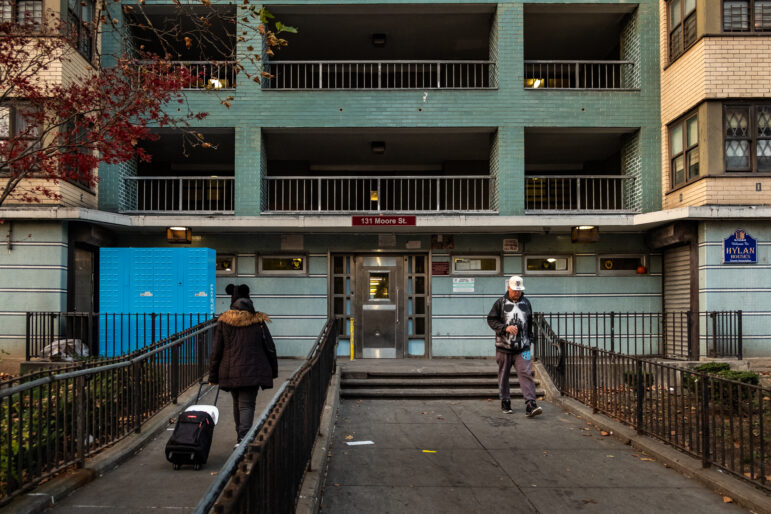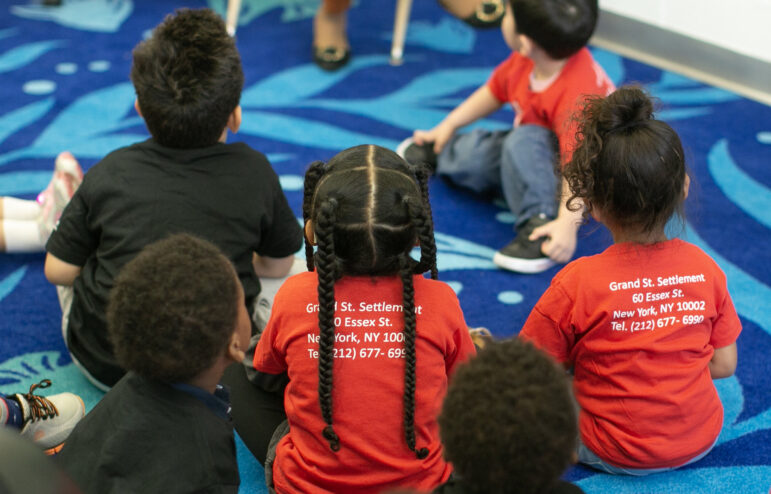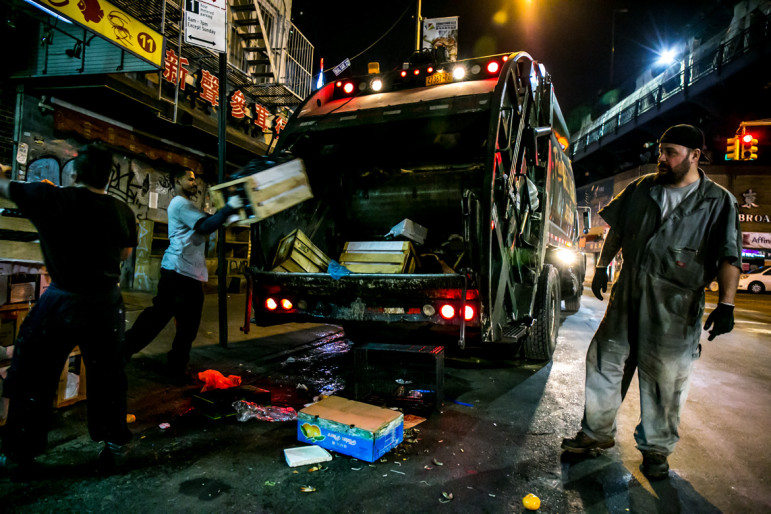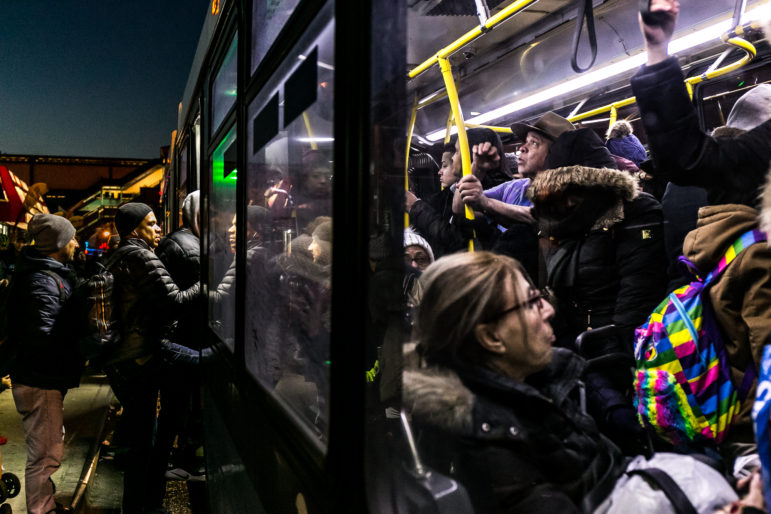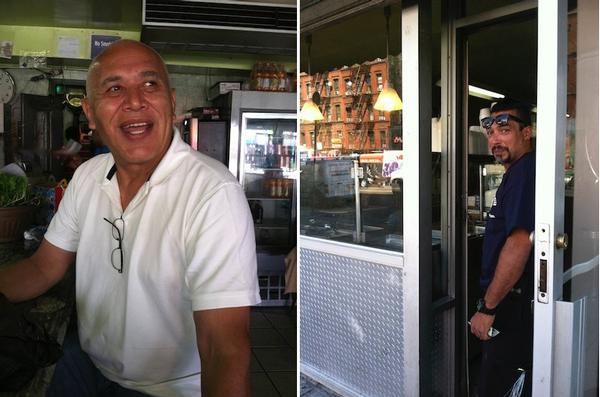
Photo by: Kate Pastor
Ramon Antunez, left, has lived in the U.S. for 43 years but only voted once, though he says he didn’t vote in his native Honduras, either. At right, Carlos Velez, 44, says he hasn’t decided who to vote for yet, but that it’s normal for him to wait until the last minute.
This article is an installment in The Five Borough Ballot, a collaboration between City Limits, City & State and WNET’s MetroFocus. In each edition of the print and video series, we return to a location in each of the five boroughs to ask real New Yorkers their take on the 2013 election as it unfolds. For a complete overview of the series, go here
At the Camaguey restaurant on 138th Street in Mott Haven, campaign season hasn’t arrived yet. Maybe it never will.
Men at the counter hunched over plates of steaming rice and meat crane their necks toward the TV screen, but it’s to watch a soccer game, not the latest campaign gaffe or fluctuating poll numbers.
Just weeks before the Sept. 10 primary, it was hard to find anyone to talk about the election and many seemed unaware there was one going on.
“This September? That’s for the president, right?” asked Ramon Antunez, 65, a regular, eating lunch at the counter one recent afternoon.
“When I come to this country I only vote one time, for George Bush,” he said. “Not even in my country I used to vote.”
Antunez is a Honduran immigrant and said he was granted political asylum in the United States after being persecuted for anti-communist activities. But he wants nothing to do with politics in the country he has called home for the last 43 years.
While concerned that there are people working below the minimum wage — “We have people right here in New York, they’re working for $3.50,” he said — he was resigned to the fact that voting would make no difference. “Politicians lie,” he said. “When they go inside the government, they clean the brain.”
A history of low turnout
Data compiled and analyzed by WNYC of adult U.S. citizens voting patterns in 2009 New York City elections — including the mayoral general election — show the voting rate around Camaguey restaurant among those eligible (not necessarily registered) was between 17 and 20 percent that year.
Two-thirds of the city’s Census tracts had less than 20 percent eligible-citizen turnout. The Bronx, where 62 percent of census tracts had fewer than 20 percent of voting-age citizens cast ballots, was the worst.
The area covering Community District 1 (in which Camaguey lies) and Community District 2 was in the bottom 10th percentile of voter turnout for both 2008 and 2009, according to “Voter Turnout in New York City,” a New York City Campaign Finance Board demographic analysis of the 2008 and 2009 elections that uses data from the U.S. Census Bureau.
Low voter turnout in the Bronx is not new. It was severe enough to have garnered the borough protection under the Voting Rights Act until key parts of the law were struck down by the Supreme Court this year. In 1971, Bronx, Manhattan and Queens were added to the group of municipalities covered under the law because fewer than half of the voting-age people were registered or voted—a problem the Justice Department linked to statewide English literacy tests for voters.
Ignored by campaigns
Now, the literacy tests are gone. But low turnout remains. And it’s mirrored by low interest from candidates running for office.
Candidates for mayor have made some 2,362 campaign stops throughout the five boroughs so far this campaign season, according to a New York Times analysis of campaign stops by all mayoral hopefuls.
But they have been largely absent from the Bronx and from Camaguey’s corner, and the sidewalk where a group of vendors hawks cookware and another peddler across the street wears a cow costume to attract the attention of passersby.
Even former Bronx Borough President Adolfo Carrion, the Independence Party nominee, has spent more time in Manhattan than in the Bronx. And Queens and Brooklyn got more love than the mainland from all of the other candidates, too.
John Liu made more campaign stops in the Bronx than any other candidate. Still, Staten Island was the only borough he visited less frequently.
Bill Thompson has trekked to the South Bronx only once; Bill deBlasio, Christine Quinn, Anthony Weiner, Joe Lhota and John A. Catsimatidis have made no stops in the South Bronx, according to the map.
It’s a vicious cycle. Voter apathy gives candidates a reason to avoid campaigning in neighborhoods where they’re unlikely to get much reward, and residents, in turn, continue to feel that the upcoming election has little to do with them.
Even when residents do show interest, campaigns don’t always react. At a candidate forum in the South Bronx in March, which was standing room only, Liu was the only one of the major party candidates to make it.
Degrees of disengagement
According to the CFB’s analysis of low-voter turnout areas, the neighborhood around Camaguey has some key demographic factors in common with other low turnout pockets in the city.
Census tracts with low voter turnout had a higher proportion of men, young adults and naturalized citizens (as opposed to citizens born in the U.S.) and displayed higher residential turnover and lower educational attainment, the study found. Just over half the population in Mott Haven, Melrose and Hunts Point has a high school diploma. Nearly a quarter of residents only made it through the ninth grade. Just one in 12 has a bachelor’s degree or higher.
Juan Carlos Lopez, 34, on of Camaguey’s regulars, moved to Sheridan Avenue in Parkchester but still makes it in for lunch.
“This area, a lot of people no have a paper,” he said, including him. He’s originally from Honduras.
If he were weighing in on the mayoral election, he said he’d consider it important for candidates to address the need for more adult educational opportunities. He took English classes nearby at a school that then shuttered its doors, he said. He struggled to find the words in English to say that he’d like to build on his year of education and have greater access to vocational training in his field of commercial construction.
Almost 70 percent of those surveyed in the two community districts — 27 percent greater than New York City overall — do not speak English as their primary language, which can be a factor in elections, the report found.
But the most significant factor in the South Bronx was transience:18.2 percent of the population lived in a different residence one year ago — at a rate almost 50 percent greater than New York City overall.
Ellion Wright, 22, is one of those people. He recently moved back to the neighborhood and was passing Camaguey on the way home from Queens, where he had travelled with his buddy, who was picking up his public assistance check.
The median household income in the two districts was $19,982, 64 percent lower than the city as a whole, according to the CFB report.
Wright said he plans to vote on the Democratic line at some point this year, but did not know who’d be on the ballot.
“I would decide only for the person for helping the people on public assistance,” he said, noting that he’d seen families suffer when benefits were cut off and that the next mayor should provide more activities, like camps, for young people
Magda Lopez, 48, travelled in her wheelchair past the restaurant. She’s a Democrat and votes in every election, she said. But she, too, has yet to tune in to the particulars.
“This year, to tell the truth, I don’t even know who’s running,” she said. Pretty soon she’ll turn on the TV to learn about her choices, she said.
The next mayor should be concerned with creating jobs, combating escalating rents, reducing the high cost of higher education, fighting crime and improving the overall welfare of the city’s minority populations, she said. But Mayor Michael Bloomberg “forgets about the minorities.”
Getting out the vote
Not so for SEIU, which is in the process of canvassing the neighborhood in a get out the vote campaign that may be the surest sign yet of a campaign season in Mott Haven.
The local 32BJ has targeted the 8th Council district as one of the 13 across the city with high member density, large numbers of Latinos and contested council races. They are encouraging people to get out to the polls, and registering people to vote.
The union is supporting Quinn for mayor, Scott Stringer for controller, Letitia James for public advocate and Mark-Viverito in the District 8 council race.
Simon Torres, S2BJ member political organizer, said he’s been out knocking on members’ doors in the district for about a month and would intensify the effort starting Aug. 10 — adding more days and volunteers and increasing the goal from 100 doors a day to thousands.
The majority of people he talks to don’t know much, if anything, about the candidates and are undecided about who they will vote for, he said, which is where he comes in: to educate them.


